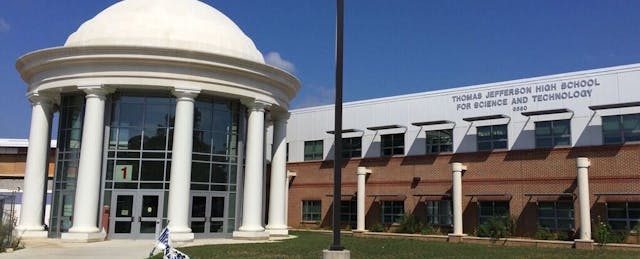Who gets to go to the best public high school in the country?
That has been a contentious question for a community just outside of Washington, D.C., after school officials made changes to the admissions process for Thomas Jefferson High School for Science and Technology last year. The stated goal was to increase the diversity of students at the public magnet school, which U.S. News & World Report named the top in the nation. But opponents say the new policy illegally erects barriers for Asian American students. (EdSurge dug into the issue on a recent episode of the Bootstraps podcast series co-produced with the journalism nonprofit Open Campus.)
On Thursday, officials announced the racial and socioeconomic makeup of the first entering class at Thomas Jefferson, or TJ as everyone in town calls it, to be chosen under the new system—which included dropping an admissions test, eliminating an application fee and ensuring that top students from each eligible middle school get to attend.
The biggest impact occurred along lines of economic class.
The proportion of economically disadvantaged students increased from less than 1 percent to 25 percent, according to a report from Fairfax County Public Schools in the Virginia county where the high school resides.
The racial makeup for the admitted class of 2025 will look significantly different than in past years as well. While last year only 1 percent of incoming students were Black, this year the percentage rose to 7 percent. The proportion of Hispanic students rose from 3 percent to 11 percent. And the number of white students went from 17 percent to 22 percent.
The only group that is suddenly less represented is Asian-American students. They make up 54 percent of the new class, while in past years, they received between 65 and 75 percent of offers.
While male students had long vastly outnumbered female students, the gender gap narrowed. Female students admitted increased from about 42 percent to 46 percent.
School board superintendent Scott S. Brabrand said in a statement that the data "speaks volumes to the fact that when we truly center our work on equity, all of our students have an opportunity to shine.”
Makya Renée Little, president of the TJ Alumni Action Group, a nonprofit that formed to push for reform at the high school, said the more representative outcomes "just made it all worth it."
“This has been an emotionally charged year, and we put in a lot of late nights, relationship building, partnership building ... and drafting strategies and reports using data,” she added.
Rachel Lei, who is also a member of the TJ Alumni Action Group, says she was pleasantly surprised to see the spike in the number of economically disadvantaged students. “Race is only the canary in the coal mine and there are inequities across many more axes,” she said in an email interview.
But a parent group opposing the changes, called the Coalition for TJ, said the numbers released this week support their objections. They filed a federal lawsuit against the school board soon after the admissions changes were made, arguing that the moves unfairly discriminate against Asian American students.
“The numbers showed about a 20 percent decline in the percentage of Asian American students,” said Erin Wilcox, an attorney representing Coalition for TJ in the case. “That’s a very significant drop.”
“The bottom line is you can’t take people's race into account when deciding who gets to go to what school,” she said. The admissions test worked well because it is “race neutral,” she said, but that the new system, which she said effectively limits the numbers any one middle school can send to TJ, blocks Asian students. “It takes advantage of the fact that Asian American students seem to be concentrated in a certain number of middle schools in Fairfax County,” she added.
Last month, a federal judge allowed the Coalition for TJ’s lawsuit to move forward, and it is now entering the discovery phase, which lasts until mid-October. At that point the parties are expected to ask the judge to issue a summary judgment, or the judge could decide to let the case move to a full trial.
Editors note: This story was updated to add additional information.


